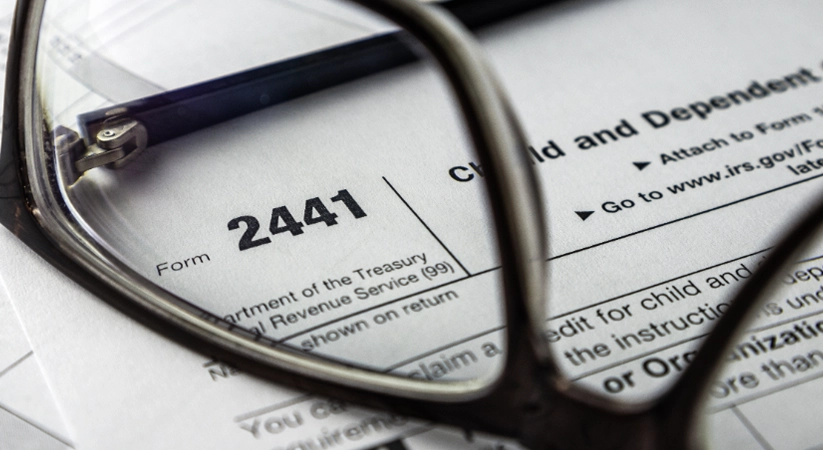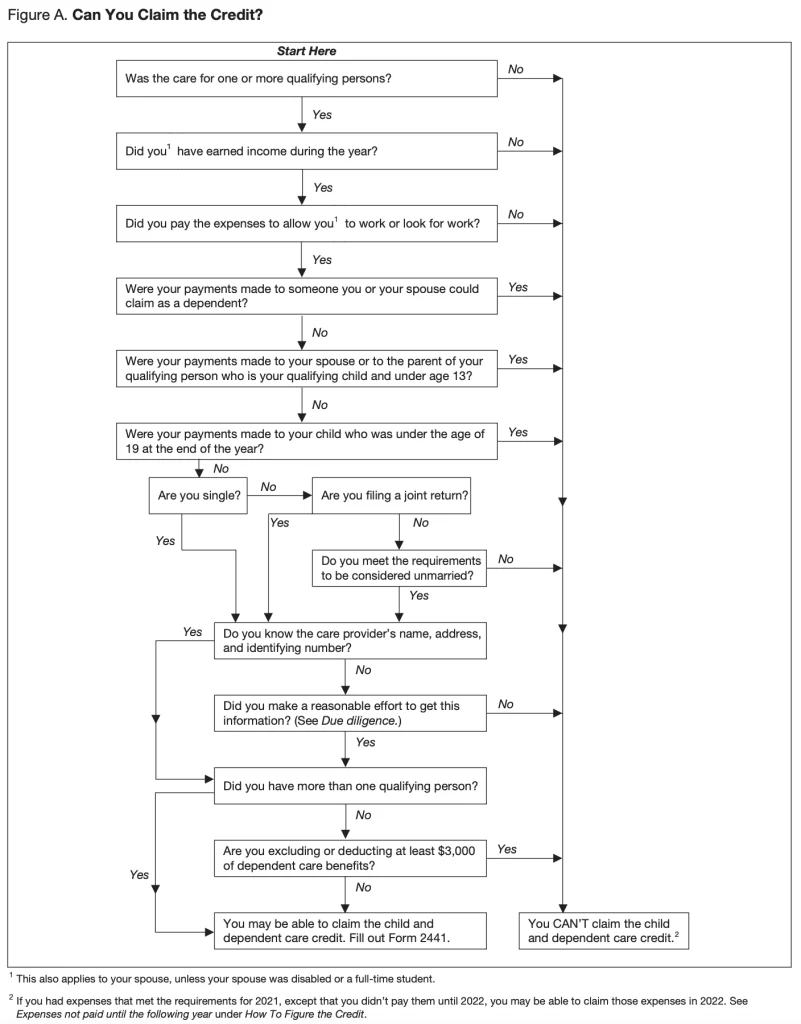
Uncle Sam’s watching the kids. As in, paying someone to help watch them. So, like most uncles?
The Child and Dependent Care Tax Credit is a tax credit to offset the cost of caring for certain persons while you work. To calculate the credit, three amounts are needed:
- The maximum expense allowed
- Actual work-related expenses minus care benefits received
- Your earned income
The maximum expense allowed is $3,000 for one qualifying individual or $6,000 for two or more qualifying individuals. Actual work-related expenses are the amount actually paid for care, minus any benefits received for that care, such as employer-provided childcare benefits. Earned income is the total amount of income earned by the taxpayer and their spouse, if married filing jointly.
To claim the dependent tax credit, you must fill out Form 2441 and attach the tax form to your federal tax return. It must provide the care provider’s information, including name, address, and taxpayer identification number or Social Security Number.
In some cases, you may not have all the required information. You can use the concept of “due diligence” to claim the tax credit. This means that you must make a reasonable effort to obtain the necessary information, such as contacting the caregiver directly. If you’re unable to obtain the information after making a reasonable effort, you can still claim it.
You yourself must also meet certain eligibility requirements, such as having a qualifying child or dependent under the age of 13 or who is disabled, and be earning income from a job or self-employment.

SOURCE | Internal Revenue Service, publication 503
What are Dependent Care Benefits?
Dependent care benefits are a form of employer-sponsored payment that helps employees with expenses related to caring for their dependents. These benefits can be paid directly to the care provider or to the employee in the form of reimbursement. The payments may be made with pre-tax contributions, which reduces the employee’s taxable income. Alternatively, the payments may reduce the employee’s salary, making the expenses excluded from taxable income. Dependent care benefits are regulated by the IRS and are subject to certain rules, with specifics laid out on Box 10 and Box 13 forms. Employers must report the fair market value of the benefits or reimbursements provided to their employees. Dependent care flexible spending programs are a form of dependent care benefits that allow employees to contribute a specified amount of their pre-tax income into the account, which they can then use to reimburse themselves for eligible dependent care expenses. Dependent care benefits help employees manage the costs of caring for their dependents, allowing them to focus on work and providing for their families.
Care you can claim
To qualify for the dependent care tax credit, the dependents must be under the age of 13 or physically or mentally incapable of caring for themselves. Moreover, they must be claimed as dependents on the taxpayer’s tax return. The care provider must not be the taxpayer’s spouse, parent, or a dependent on the tax return. The qualified care provider can be a daycare center, babysitter, or another individual who provided the care.
Taxpayers should also consider using a flexible spending account (FSA) to cover their dependent care expenses. An FSA allows employees to use pre-tax dollars to pay for eligible expenses, including dependent care. Think of it as a prepaid healthcare credit card. Depending on the taxpayer’s income level and tax bracket, using an FSA could result in higher tax savings compared to claiming the credit.
Benefits of the tax credit
The Child and Dependent Care Credit is a tax credit that provides a direct reduction in the amount of a taxpayer’s federal income tax liability. This credit is designed to assist taxpayers with the costs of caring for a child, dependent child, or other dependent, so they can work or look for work. The credit can be up to 35% of eligible expenses, depending on income level, up to a maximum of $3,000 for one dependent or $6,000 for two or more dependents.
Income limits apply to the credit, and the percentage of the expenses that can be claimed decreases as income increases. For example, taxpayers with an adjusted gross income (AGI) of over $125,000 can only claim 20% of eligible expenses.
The history of the Child and Dependent Care Credit dates back to 1976 when it was first introduced. The Tax Cuts and Jobs Act of 2017 changed the credit by removing the dependent care benefits exclusion, which allowed employers to give employees up to $5,000 a year in dependent care expenses without being taxed.
What’s the right way to calculate my dependent care tax credit?
The Child and Dependent Care Credit allows taxpayers to reclaim a percentage of childcare expenses on their tax return, reducing the amount of tax owed or increasing their tax refund.
First, taxpayers must meet certain requirements and calculate the eligible expenses correctly.
What earned income”?
To calculate the childcare tax credit, you must first determine your earned income. Earned income includes taxable employee compensation and self-employment income. For taxable employee compensation, earned income is calculated as the sum of wages, salaries, tips, and other taxable employee compensation. For self-employment income, earned income is calculated as net earnings from self-employment, which is your gross income minus your expenses.
Special rules apply when both spouses are employed. In this case, earned income is calculated as the sum of the spouse’s taxable employee compensation and net earnings from self-employment, as long as both spouses have earned income. However, if one spouse does not have earned income or is a full-time student, the couple may not be eligible for the childcare tax credit.
Your earned income sets the limit for work-related child and dependent care expenses. This means that the amount of work-related child and dependent care expenses that can be used in the credit calculation is limited to the lower of the taxpayer’s actual work-related expenses or their earned income. For example, if your earned income is $5,000, the work-related expenses used in the credit calculation cannot exceed $5,000. It’s important to note that not all work-related expenses qualify for the credit.
Self Employment Income
Self-employment income can impact the computation of the childcare tax credit for taxpayers who are self-employed. In order to determine earned income for the purpose of calculating the credit, both taxable employee compensation and net earnings from self-employment are included. Net earnings from self-employment are defined as gross income from a trade or business minus allowable deductions.
For self-employed taxpayers, there are certain circumstances where the earned income limit may be reduced. For example, if a taxpayer has a net loss from self-employment, this loss is subtracted from their taxable employee compensation to determine their earned income. If the resulting earned income is less than $2,500, the earned income limit is reduced.
Who counts as a qualified care giver for tax purposes?
Not all individuals are eligible to provide care expenses that can be included in filing for the Child and Dependent Care Tax Credit. For instance, the taxpayer’s spouse or a parent of the qualifying individual cannot be claimed as a care provider. Moreover, the taxpayer cannot claim the credit for care provided by their child who is under the age of 19. Child and dependent care expenses count when they’re a cost while the tax payer is trying to find work or working.
To be considered as a qualified care provider, an individual must meet certain eligibility requirements. Firstly, the provider must not be the taxpayer or their spouse. Secondly, they must have provided care for the dependent while the taxpayer was working or actively seeking employment. Lastly, the care provider must have been identified on the taxpayer’s tax return or a separate statement attached to it.
It is essential to note that claiming the tax credit is limited if the care provider does not meet the eligibility requirements. For instance, the credit is limited to the actual qualifying expenses paid to the provider if they are an individual who is not carrying on the trade or business of providing care services. Additionally, the credit is limited to the amount paid to a care provider who is a relative of the taxpayer if they are under the age of 19, or if they are the taxpayer’s spouse.
Claiming the Dependent Care Tax Credit
Claiming the Dependent Care Tax Credit can help ease the financial burden of childcare costs for many taxpayers. This credit provides a dollar-for-dollar reduction in taxes owed based on expenses incurred for the care of a dependent child or adult. Eligible expenses include fees paid to a daycare center, babysitter, or nanny, as well as expenses for summer day camp and before or after-school programs. However, there are a few requirements that must be met in order to claim this credit. For example, both the taxpayer and their spouse (if married) must have earned income during the tax year, and the care must have been necessary for the individual to work or actively seek employment.
To claim the childcare tax credit, what do I need when I file my taxes?
It starts with Form 2441, where you put information on your child or dependent are provider, including their name, address, and taxpayer identification number. You also need to provide the Social Security Number of each qualifying person to claim the credit.
To qualify for the child tax credit, you and your qualifying child must pass seven “tests”: age, relationship, support, dependent status, citizenship, length of residency, and joint return. The child must be under age 13 or be a qualifying individual who is physically or mentally incapable of caring for themselves. They must be your child, stepchild, foster child, brother, sister, stepbrother, stepsister or a descendant of any of them.
Additionally, the child must live with you for more than half the year and must not provide more than half of their own support.
Child tax credit vs. the childcare tax credit
The child tax credit and the child and dependent care credit are two important tax incentives available to working parents in the United States. The child tax credit allows taxpayers to claim a credit of up to $3,600 per child under 6 years old or $3,000 per child between 6 and 17 years old. This credit is non-refundable but can reduce the amount of taxes owed.
On the other hand, the child and dependent care credit is a credit for child care expenses. It allows taxpayers to claim a credit of up to $4,000 for one qualifying dependent, or up to $8,000 for two or more dependents, for expenses related to day camp, after-school care, and other care expenses. This credit is also non-refundable but can reduce the amount of taxes owed.
Both credits have undergone changes throughout the years, with the most recent changes made by the American Rescue Plan Act of 2021. One significant change to the child tax credit is the increase in the maximum credit amount and the expansion of eligibility to more families, including those with little or no taxable income. The child and dependent care credit was also expanded to increase the maximum credit amount from $3,000 to $4,000 for one dependent and from $6,000 to $8,000 for two or more dependents, and the income limit for the credit was raised from $15,000 to $125,000.
To qualify for the child tax credit, taxpayers must have a child under the age of 18 at the end of the tax year, and the child must have a valid social security number. There are also income limits for the credit, with a phaseout starting at $200,000 for single filers and $400,000 for married filing jointly. To qualify for the child and dependent care credit, taxpayers must have earned income and incur care expenses for a qualifying dependent, which includes children under the age of 13 and dependents who are unable to care for themselves. The credit also has income limits, with a phaseout starting at $125,000.
More Frequently Asked Questions about the Child and Dependent Care Tax Credit
- How do I know if I’m eligible for the tax credit?
Taxpayers who have earned income and incur care expenses for a qualifying dependent, such as a child under the age of 13 or a dependent who is unable to care for themselves, may qualify for the credit.
- What expenses can be claimed for the credit?
Expenses related to care given in order for the taxpayer to be able to work or look for work can be claimed, such as expenses for day care centers, nannies, and after-school programs.
- What is the maximum amount that can be claimed for the credit?
The maximum credit amount is $3,000 for one qualifying dependent and $6,000 for two or more dependents.
- Is there an income limit to claim the credit?
Yes, the credit has income limits. Taxpayers with an adjusted gross income over $125,000 may be subject to a reduced credit amount.
- How is the credit calculated?
The credit is a percentage of the expenses incurred, ranging from 20-35% depending on the taxpayer’s income level.
- Are there any exemptions to claiming the credit?
Taxpayers who receive dependent care benefits from their employer may need to reduce their credit amount by the amount of the benefits received.
- How is the credit paid out?
The credit is claimed on the taxpayer’s tax return and can reduce the amount of taxes owed or result in a refund. It cannot be received in advance. It’s also a nonrefundable tax credit.

Sarah Nieschalk
Sarah E. Deierlein Nieschalk, EA, is an experienced tax professional with over a decade of expertise representing taxpayers before the IRS. As an Enrolled Agent and Assistant Vice President of Servicing at Community Tax, LLC, Sarah specializes in resolving complex federal and state tax collection issues, including high-dollar individual liabilities, employment tax challenges, and corporate audits. Since becoming an Enrolled Agent in 2012, she has resolved over 5,000 cases, saving millions for clients while protecting countless businesses. Outside of work, Sarah enjoys painting, staying active, and raising her family of rescued dogs while contributing to nonprofit causes through storytelling events.








